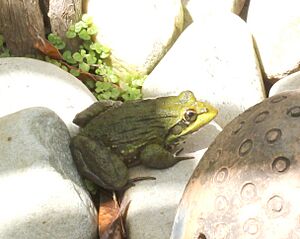Cape river frog facts for kids
Quick facts for kids Cape river frog |
|
|---|---|
 |
|
| Conservation status | |
| Scientific classification | |
| Synonyms | |
|
The Cape river frog (Amietia fuscigula) is a type of frog that lives in South Africa. It is named after the Cape of Good Hope. These frogs are mostly found in the Eastern Cape and Western Cape provinces. They belong to the frog family called Pyxicephalidae. A new frog species, A. poyntoni, was identified and separated from this species in 2013.
Contents
What Does the Cape River Frog Look Like?
The Cape river frog is a fairly large frog. It can grow up to about 12.5 cm long from its nose to its bottom. Its snout, or nose area, is slightly rounded. These frogs have a strong, athletic body with long back legs and webbed feet. This makes them excellent at jumping and very powerful swimmers. Their front feet, however, are not webbed. When a frog sits still, its longest back toe reaches up to its ear drum.
The skin on their belly (underside) is smooth and white. But their throat often has dark spots. This spotting is why they were named fuscigula, which means "dusky throated" in Latin. Sometimes, these dark spots can even spread to their belly. The skin on their back has a few small, round bumps and some short ridges. Their color can vary a lot. They can be dark brown, light brown, green, or even olive-colored. Their back and legs usually have darker, irregular blotches.
Male and female Cape river frogs look very similar. However, during the breeding season, males develop a dark, swollen pad on each thumb. This is called a nuptial pad. The frog's eyes and ear drums (called tympanum) are easy to see. The ear drum is almost as big as the eye.

Where Do Cape River Frogs Live?
Cape river frogs live in many different places. They can be found in both cool (temperate) and warm (tropical) areas. They need fresh water for breeding, even if it's only there for part of the year. You can find them in places like farms, grasslands, savannas, and shrublands. They also live near rivers, swamps, lakes, marshes, and springs. They are often found in man-made water bodies too, like ponds, dams, and even sewage treatment areas. Sometimes, they will even live and breed in water containers like rainwater butts or horse troughs.
What Are the Habits of Cape River Frogs?
Cape river frogs are mostly active during the day. However, they usually call and breed at night or around dawn and dusk. They prefer to live in places with permanent water, like dams. But in some areas, they only live in water bodies that appear seasonally. If they live in farm dams, they often come out in the morning to sit on the bank and warm up in the sun. They hide when the sun gets too hot around noon.
When they are basking, predators like herons might try to catch them. Because of this, they are very shy. If something approaches, you might hear a series of "plops" as the frogs jump into the water. When they jump in, they dive strongly and hide under logs or stones. They might also stir up mud to create a cloud and hide themselves. However, if they live in places like garden ponds, they can get used to people being around.
The calls of the Cape river frog can be quite different. This is especially true when they are with other noisy frog species. Males can call at any time of the year, but they call most often during the breeding season. A typical call starts with a rattling sound, like running a thumbnail over a comb. This is followed by a few short croaks. When many males are calling together, their calls become higher in pitch, louder, and faster.
These frogs are active hunters. They will eat medium-sized invertebrates like crickets. But they also hunt small reptiles, mammals, and other amphibians. This includes smaller frogs of their own kind.
When living in streams and ditches, Cape river frogs like deep ponds. These are often found below where water flows in, creating hollow shelters. They also prefer deep, still water for breeding. Their tadpoles grow quite slowly in these conditions but can become very large. In shallow streams, the tadpoles grow faster but turn into smaller young frogs. A fully grown tadpole is usually about 8 cm long. But in deep, cool, permanent water, they can grow to twice that length! In warm, shallow water with lots of food, it might take about 9 months to a year for them to develop. But in cold, deep water with little food, it could take two years.
The tadpoles are strong swimmers with large tails. Their tails are about two to three times longer than their body and taper to a point. Their body is oval-shaped.
What is the Status of the Cape River Frog?
The Cape river frog is currently listed as "least concern." This means that scientists are not worried about it becoming endangered. Even though it might be threatened in some local areas by things like dam building, it is found in large numbers over wide areas. It can also survive in changed habitats, such as suitable farmland.


